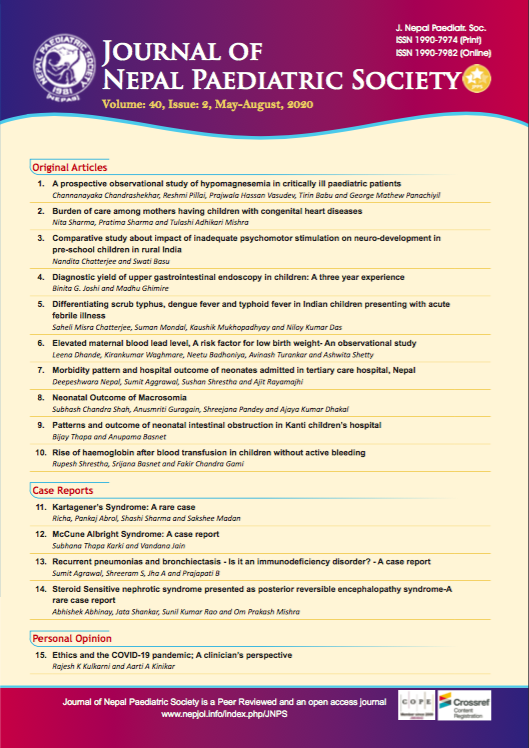Kartagener’s Syndrome: A Rare Case
DOI:
https://doi.org/10.3126/jnps.v40i2.28845Keywords:
Bronchiectasis, Dynein, Kartagener's syndrome, Primary ciliary dyskinesia, Situs, inversusAbstract
Kartagener’s syndrome, an autosomal recessively inherited disorder, is a subgroup of primary ciliary dyskinesias. This genetic disorder manifests from early life which distinguishes it from acquired mucociliary disorders. Kartagener’s syndrome presents as a classical triad of situs inversus, sinusitis and bronchiectasis occurring majorly due to impaired ciliary motility. Here we report a case of a four year old female child who presented to us with repeated episodes of cough and intermittent breathlessness for the past three years. Clinical examination revealed bilateral coarse basal crepitations and apex beat on right fifth intercostal space in the midclavicular line. A thorough investigation revealed situs inversus, chronic sinusitis, and bilateral bronchiectasis. The patient underwent a high-speed video microscopy analysis which was suggestive of primary ciliary dyskinesia. Considering these findings, the patient was diagnosed as a case of Kartagener’s syndrome.
Downloads
Downloads
Published
How to Cite
Issue
Section
License
Authors who publish with this journal agree to the following terms:
Authors retain copyright and grant the journal right of first publication with the work simultaneously licensed under a Creative Commons Attribution License that allows others to share the work with an acknowledgement of the work's authorship and initial publication in this journal.
Authors are able to enter into separate, additional contractual arrangements for the non-exclusive distribution of the journal's published version of the work (e.g., post it to an institutional repository or publish it in a book), with an acknowledgement of its initial publication in this journal.
Authors are permitted and encouraged to post their work online (e.g., in institutional repositories or on their website) prior to and during the submission process, as it can lead to productive exchanges, as well as earlier and greater citation of published work (See The Effect of Open Access).



